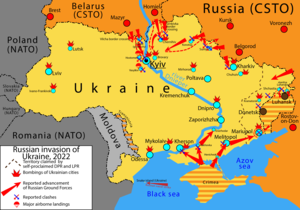See all articles relating to: Russia
As of 2020, according to the United Nations data, Russia ranks third in the world in terms of the number of emigrants in absolute numbers (10.65 million people or 6.8% of the population), following India (17.79 million people or 1.3% of the population) and Mexico (11.07 million people or 7.9% of the population). As of 2021, UN estimates indicate that over 10 million people of Russian origin reside abroad, making it the third-largest diaspora in the world after the Indian and Mexican diasporas.[1]
Mass emigration from Russia follows a cyclical pattern, characterized by surges linked to economic, social, and political upheavals, referred to as "waves of emigration." Prior to 2014, before the outbreak of the Russo-Ukrainian conflict, it was officially acknowledged that Russia had undergone four waves of emigration. Since 2014, and especially after February 2022 when Russia invaded Ukraine, the country has experienced a mass exodus of approximately one million people. This substantial outflow provides sufficient grounds to consider the current departure of Russian citizens as the fifth wave of emigration.
First wave (1917-1924)

During the period from 1918 to 1924, following the October Revolution, between 1 to 1.5 million people left Russia. A significant portion of them had fought in the White Army. Alongside military personnel, the country saw the departure of political emigrants, estimated to be around 2 million people.[2]
The total number of emigrants from Russia as of November 1, 1920, according to calculations by the American Red Cross, amounted to 1,194,000 people. According to the League of Nations, by August 1921, there were more than 1.4 million refugees from Russia worldwide. By November 1, 1921, the American Red Cross estimated that Russian emigration had reached 2 million people.
Second wave (1941-1945)
Amid World War II, numerous Soviet citizens found themselves on Nazi German territory for various reasons. This included individuals forced to work in Germany and Soviet prisoners of war. After the war, some chose not to return to the USSR. Moreover, during the retreat of German occupiers and their allies from the Soviet Union, certain inhabitants of occupied territories voluntarily evacuated. Officially, after the war's conclusion, approximately 130,000 people chose not to return to the country.[3]
Third wave (1965-1988)

Emigrants of the "third wave" left the USSR legally with the authorities' consent. A significant portion of these emigrants were Jewish, permitted to leave for Israel (some ended up in the United States or other countries). The total number of third wave emigrants is generally estimated at around 500,000 people.
From 1945 to 1955, only 500 Soviet citizens (50 people per year) left for the Mandate Palestine and later to Israel. Between 1955 and 1965, 4,167 Soviet citizens, mainly of advanced age, immigrated to Israel (approximately 500 people per year).
In 1965, a quota for Jewish emigration from the USSR was established at 1,500 people per year. Those with school-age children, considered "valuable specialists," were enlisted for military service, and those with access to state secrets were not allowed to emigrate. In February 1967, the quota was increased to 5,000 people per year, but the Six-Day War of 1967 soon interrupted emigration to Israel. It resumed in June 1968, with a lowered quota. Only in March 1970 was the quota raised to 3,000 people per year.
Fourth wave (1989-2000)
Following the start of Perestroika, Soviet citizens gained the right to travel abroad with minimal restrictions. Official data shows that from 1989 to 2002, a total of 1.26 million people left Russia for permanent residency in "distant foreign countries." A significant portion of these emigrants were also Jewish, relocating to Israel and Germany, as well as Germans, Greeks, and others. A distinctive feature of this wave was the "brain drain," as many talented scientists and intellectuals left the country. Throughout the 1990s, emigration primarily had an economic character. It also had a strong ethnic component: for example, ethnic Germans were leaving for Germany in large numbers, Jews for Israel, Greeks for Greece, and so on.
Fifth wave (2014 until present)

Since the onset of the Russian-Ukrainian conflict in 2014, the emigration situation in Russia has witnessed significant shifts. The war, coupled with the annexation of Crimea and ongoing turmoil in Eastern Ukraine, has sparked a notable increase in emigration. By 2021, it is estimated that over 300,000 individuals have left Russia due to the conflict and its aftermath. Many emigrants are individuals of Ukrainian descent who fear potential discrimination or security risks. Furthermore, a portion of Russians critical of their government's actions in the conflict have also chosen to seek refuge abroad. As a result, countries sympathetic to Ukraine or offering protection from political repercussions have seen an uptick in asylum applications from Russian citizens.
After the commencement of the Russian invasion of Ukraine in late February 2022, it is believed that over 300,000 individuals who were either Russian citizens or residents departed Russia by mid-March 2022. By the close of August 2022, the number is estimated to have risen to at least 500,000. Furthermore, an additional 400,000 people left Russia by early October, resulting in an approximate total of 900,000 individuals. This figure encompasses a range of individuals, including economic migrants, conscientious objectors, and a portion of political refugees.
Russian nationals have selected a variety of destinations for their emigration, with Turkey emerging as a popular choice, where over 100,000 Russians have sought residency. Georgia and Armenia have also welcomed a significant influx of Russian emigrants. By early April, approximately 100,000 Russians had sought refuge in Georgia, while around 50,000 had chosen Armenia as their destination. Notably, Serbia has recorded the stay of 104,000 Russian citizens in 2022.
In Latin America, Argentina has become a notable destination, particularly for more than 5,000 pregnant Russian women who opted to give birth there. This choice is driven by the ease of obtaining visas, automatic nationality for newborns, and access to free healthcare.
Other prominent destinations encompass Azerbaijan, the United Arab Emirates, Greece, Bulgaria, Romania, Kazakhstan, Kyrgyzstan, Uzbekistan, Spain, Israel, Tajikistan, Mongolia, various Latin American countries, the Baltic states, and the United States.
See also:
Search for records in Russia
Explore more about Russian emigration
- Russians Immigrating to the United States record collection at MyHeritage
- Immigration & travel records on MyHeritage
- Best Internet Resources for East European Genealogy, webinar by Lisa A. Alzo, M.F.A. on Legacy Family Tree Webinars
- Break Down Brick Walls in Eastern European Research — Tips, Tools and Tricks, webinar by Lisa A. Alzo on Legacy Family Tree Webinars
References
- ↑ https://publications.iom.int/system/files/pdf/WMR-2022.pdf
- ↑ https://rg.ru/2020/11/12/pochemu-volny-emigracii-vytalkivaiut-rossiian-iz-svoej-zemli.html
- ↑ https://ru.wikipedia.org/wiki/%D0%AD%D0%BC%D0%B8%D0%B3%D1%80%D0%B0%D1%86%D0%B8%D1%8F_%D0%B8%D0%B7_%D0%A0%D0%BE%D1%81%D1%81%D0%B8%D0%B8#cite_note-%D0%B0%D0%B2%D1%82%D0%BE%D1%81%D1%81%D1%8B%D0%BB%D0%BA%D0%B01-9